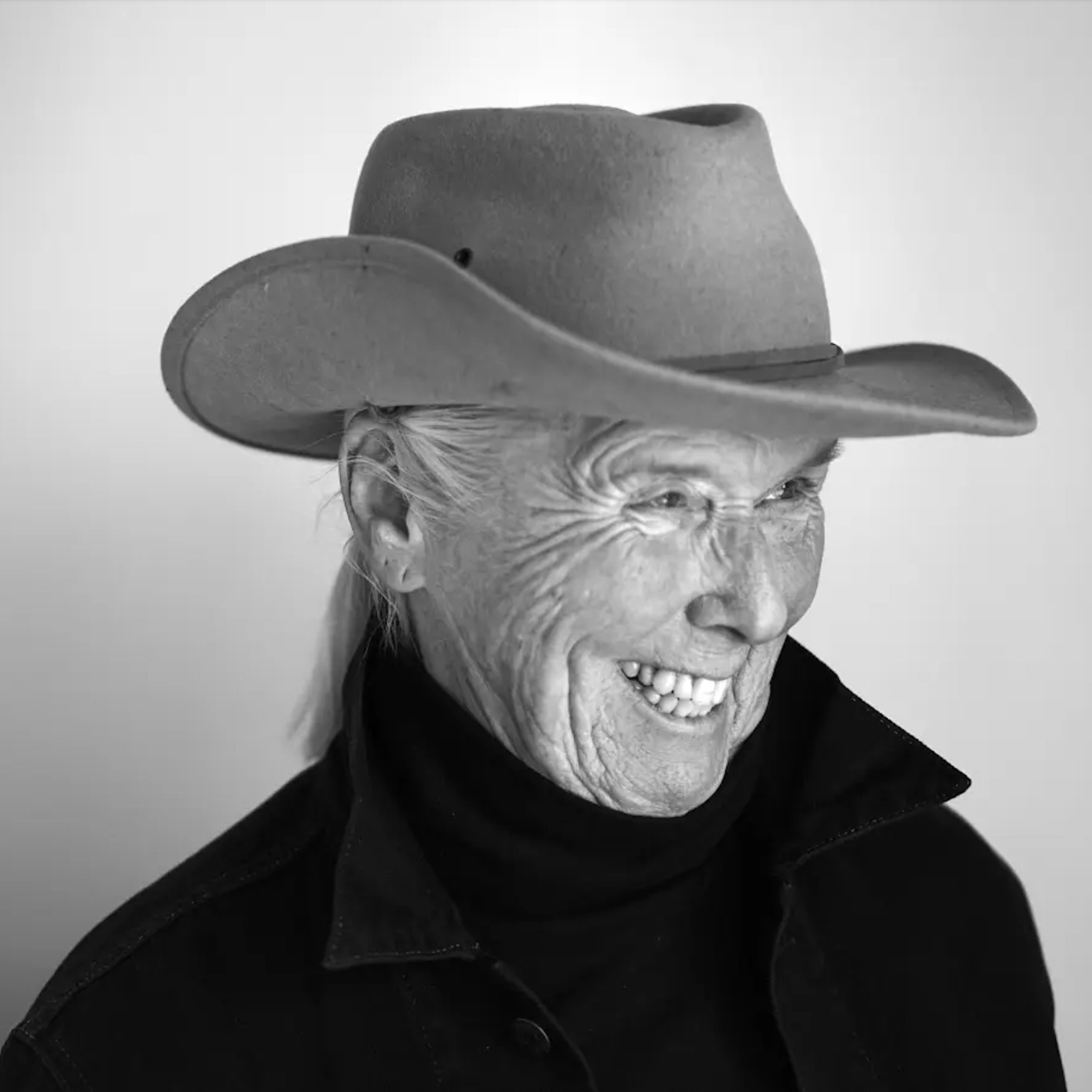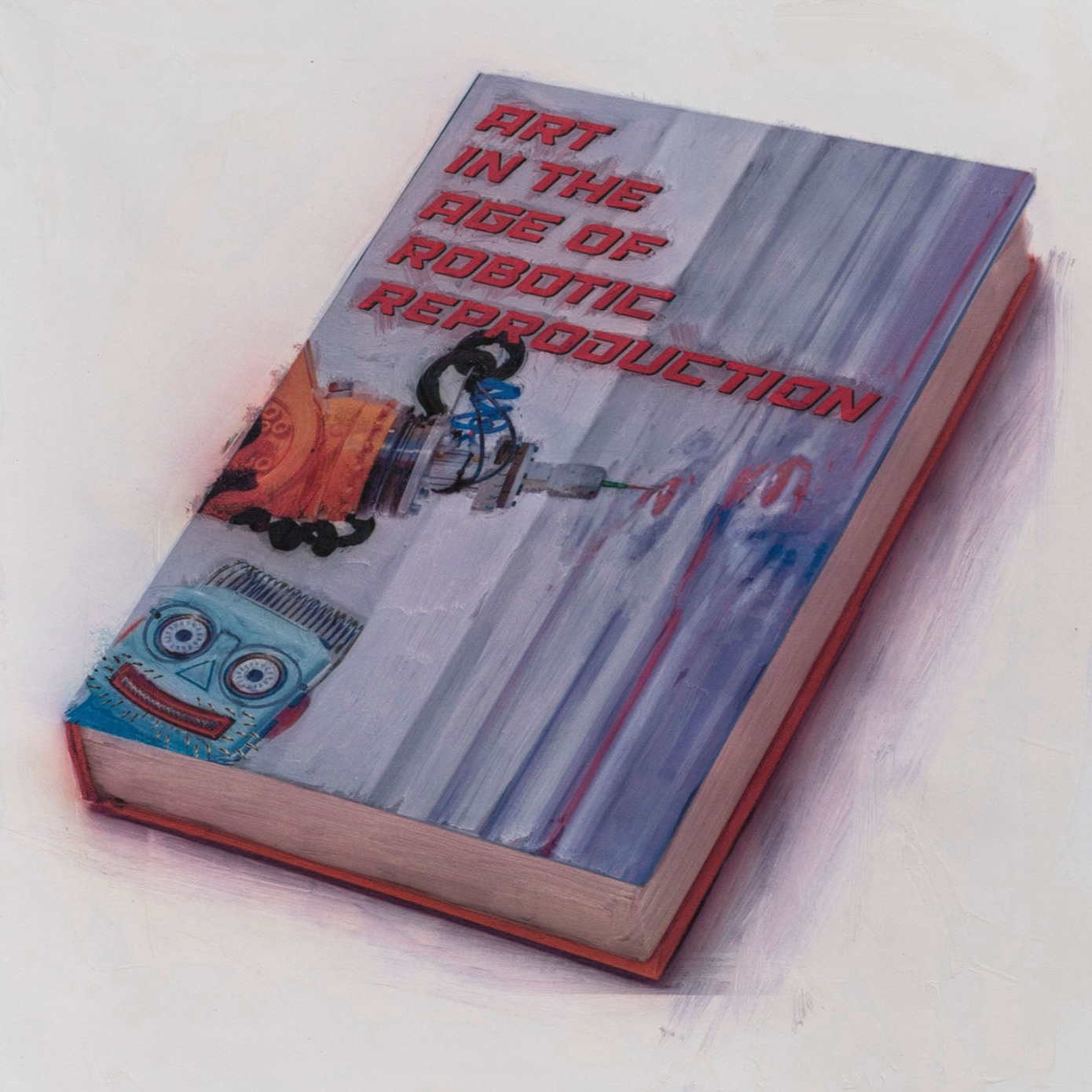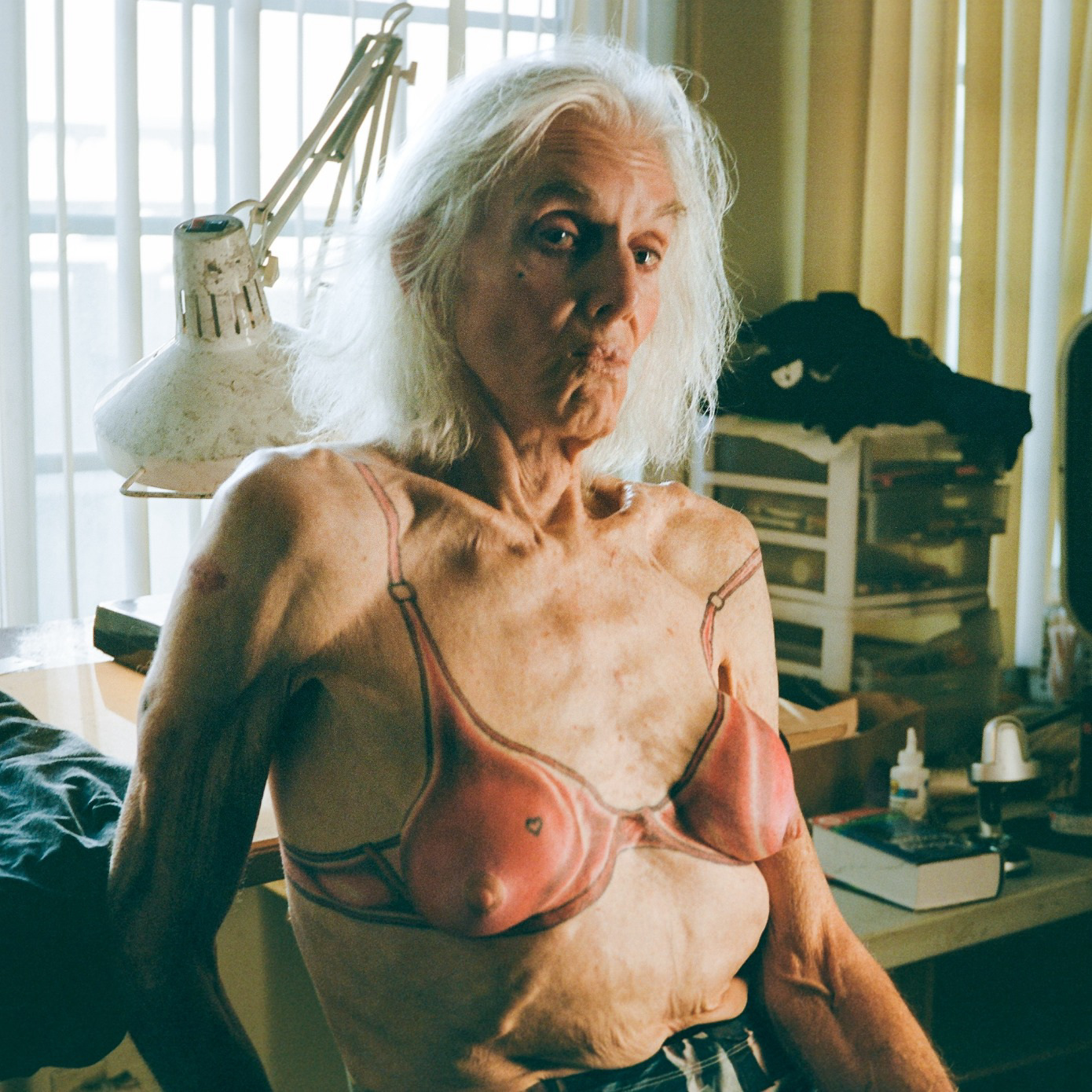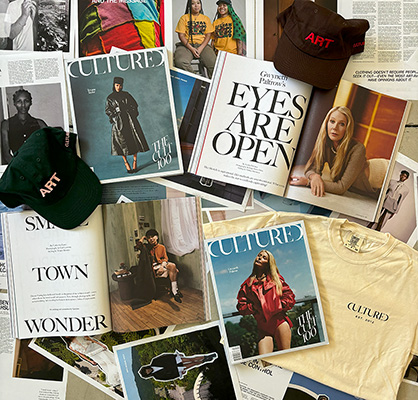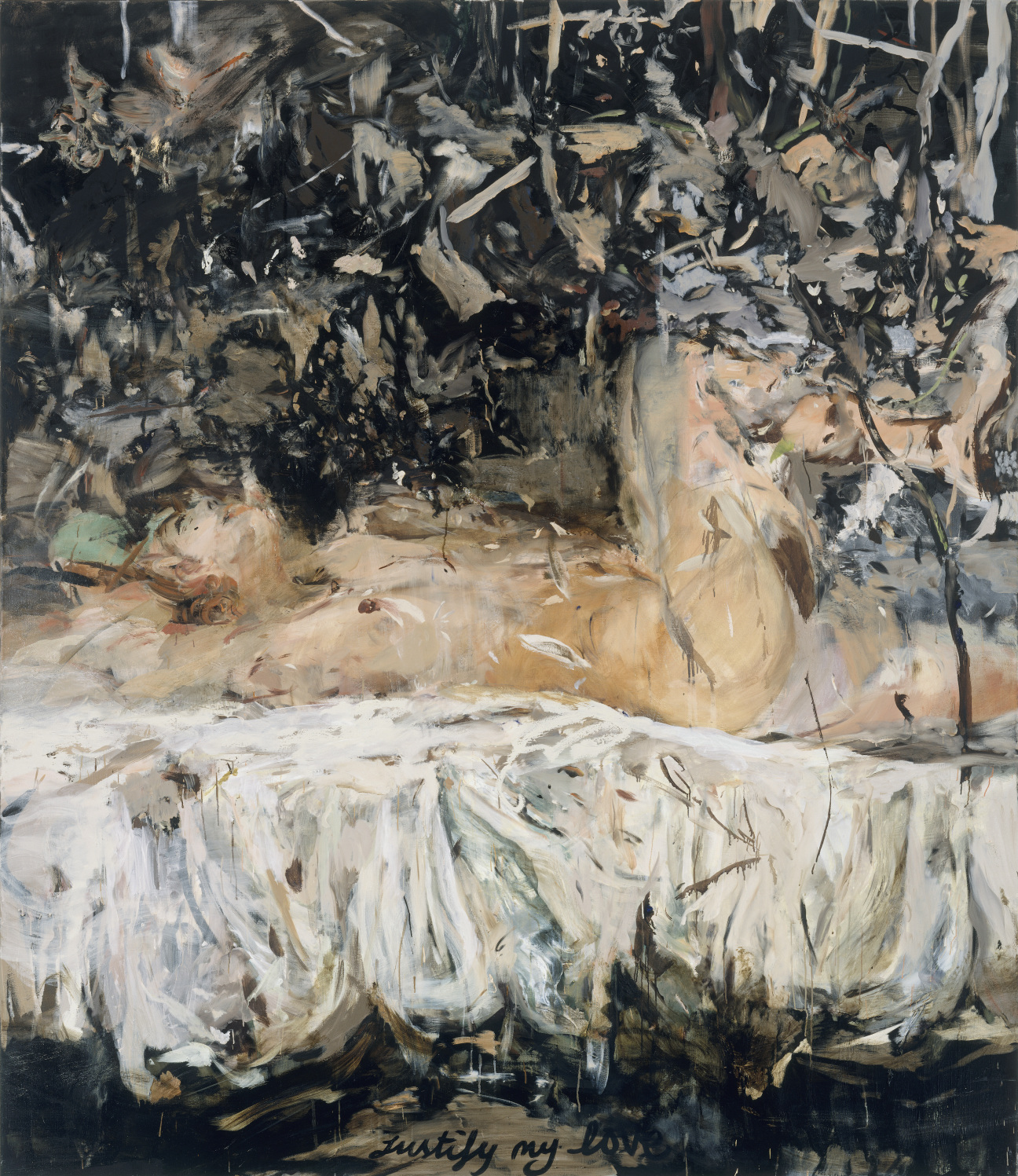
Cecily Brown
The Barnes Foundation | 2025 Benjamin Franklin Parkway, Philadelphia
Through May 25, 2025
In Cecily Brown’s canvas Justify My Love, 2003-04, a masturbating nude is rendered with all the friction and viscosity that the depicted act of sexual sovereignty suggests. The blurred figure, composed of brushstrokes that recall smears of foundation makeup in shades from ivory to bronze, seems to sail on dark water in a grisaille storm, a bed for a raft, leaving several centuries of Western art history in its wake. At the bottom, the painting’s title, taken from Madonna’s 1990 hit—whose video was famously banned by MTV for its suggestions of bisexuality, group sex, voyeurism, and BDSM—is inscribed in cursive. The work’s other reference (or one of them) Brown says, is Henry Fuseli’s Nightmare, 1781, in which an incubus crouches on a sleeping woman’s chest.
This Madge tribute (of sorts) is the most ecstatic in a trio of her Black Paintings, all from around the same time, included in “Themes and Variations,” the artist’s mid-career survey at the Barnes Foundation in Philadelphia. (Curated by Simonetta Fraquelli and Anna Katherine Brodbeck, co-organized with the Dallas Museum of Art, it’s the largest presentation of Brown’s work in the U.S. yet.) Installed on facing walls in a kind of angled passageway, catching visitors in a seductive, disorienting triangle, the three paintings make for a stunning moment staged early on in the show. They’re outliers, marking Brown’s dramatic pivot to a constrained palette and single-figure compositions after several closely watched and remarked-upon years of exuberant, kaleidoscopic color and roiling group scenes (she soon pivoted back), but the saucy allure of Justify may be a good place to start for this retrospective, which takes as its subject the artist’s relationship to the cultural politics of the past three decades.
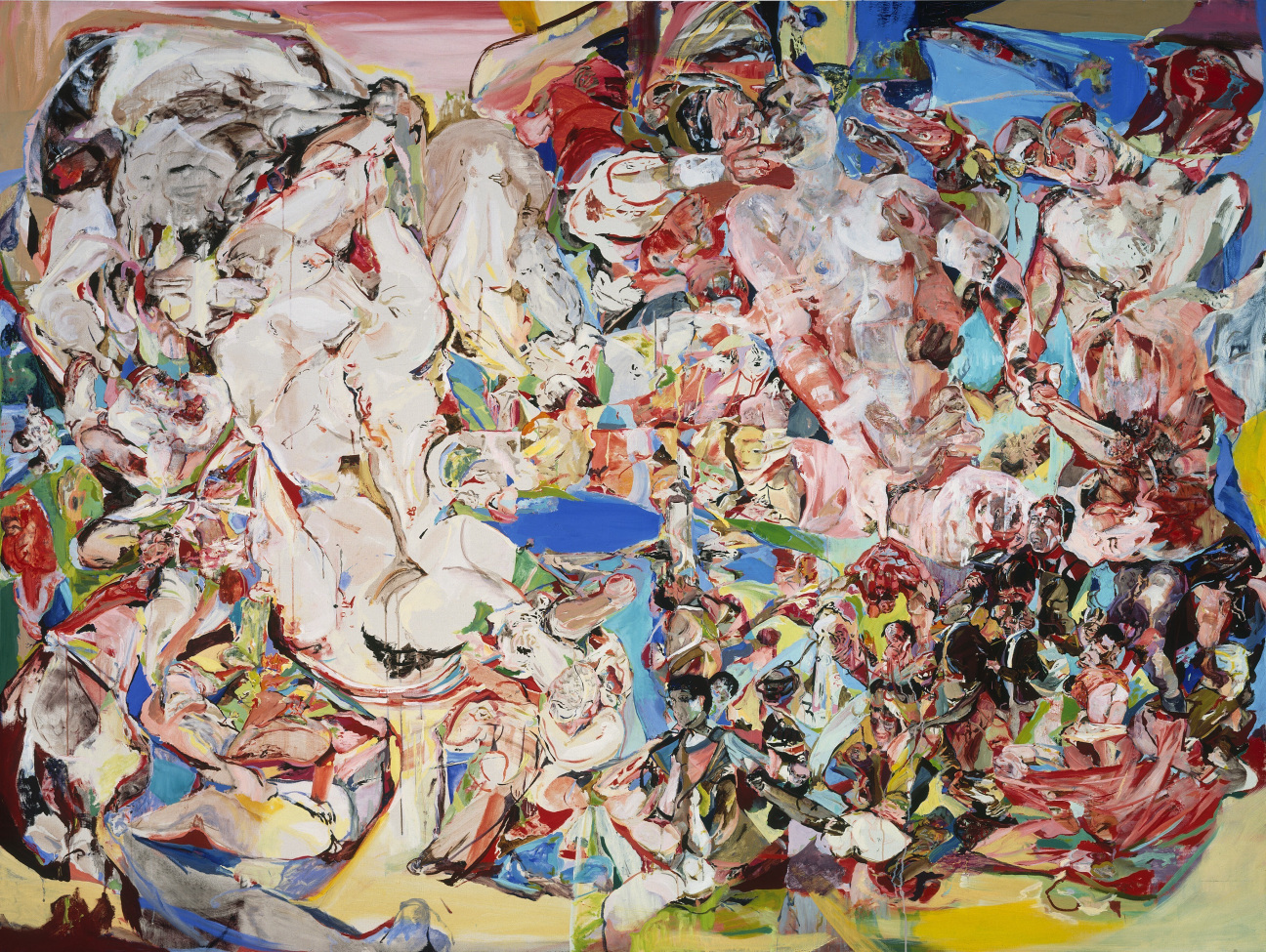
“I still had this big chip on my shoulder about being a painter,” Brown comments during a marathon walkthrough of the show, referencing the ’00s—when the ’90 restoration of the medium’s credibility was somewhat fresh. “I thought, you've got to make people look and look again. They could easily just walk into a room of colorful, semi-abstract things and be like, ‘ugh, painting.’ But then, if they see something like this,” she says, standing surrounded by the Black Paintings, “they might say, ‘wait, what?’ I always wanted that wait, what thing.”
Her desire to elicit double takes, to keep people guessing, might explain the optical double entendres she’s known for—or charged with. She has long purposely fostered “a sense that you might see something,” she explains. While people sometimes thought, at first, that she was “hiding the sexy content,” she clarifies: “that wasn't really ever my plan.” Neither was it exactly her plan, I don’t think, to wield de Kooning’s slashing marks, Fragonard’s fêtes galantes, and Delacroix’s battlefields against the visual regime we gesture toward with that hackneyed phrase the male gaze. You could argue that she did, and still does, do something like this (the curatorial framing and wall labels certainly make the case). But neither element of her work (its sexiness or the related long-game feminist riposte that hums through it) seems like her art’s raison d’être—not like the wait, what thing does.
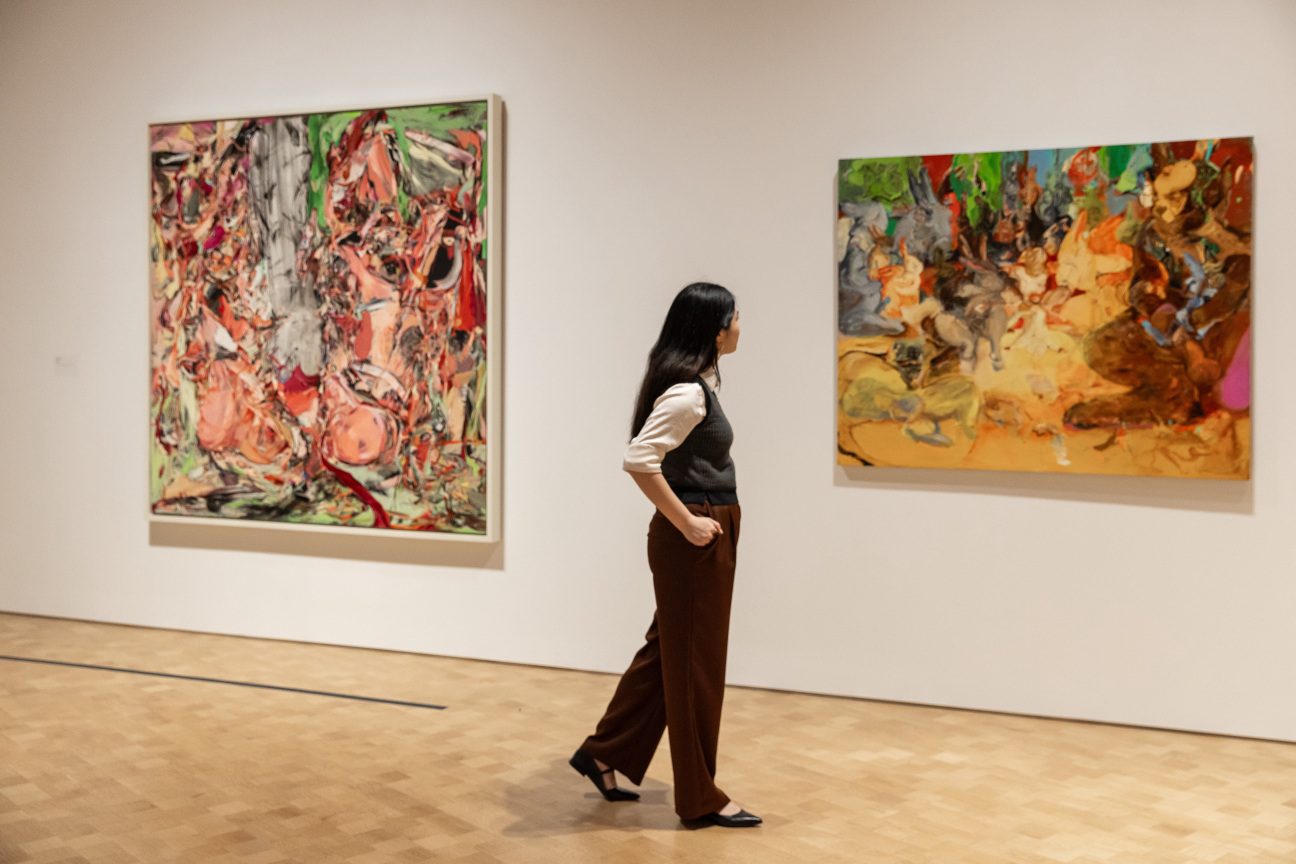
The British artist, who has been based in New York since 1994, set the art world abuzz with her 1997 solo debut. She was, in those early days, too hot and too successful—a seemingly impossible condition that is nevertheless real in a world rife with sexist paradox—and so was charged with prolific vacuity, pointless provocation, a frenetically arbitrary composting of painting history, her work measured against the hype surrounding her and the prices determined by a salivating market. Roberta Smith, for the occasion of Brown’s 2023 exhibition “Death and the Maid” at the Met—another impressive retrospective, with only a few works overlapping with the selections here—issued a mea culpa. Looking back at a 2000 review, the Times critic reflected, “I had not let my looking be slowed and had taken the unusual complexities of Brown’s art as simple busyness.”
“Busy” is, of course, accurate, as far as it goes. Brown announced herself as a force, in her first New York solo show, with bunnies: An untitled example of her use of the animals, from 1996, captures, in a loosely gestural composition, an unsettling bacchanal of multi-color rabbits, with one limp and splayed out—raped, maybe—at the spotlit center. Two years later, in works such as On the Town, 1998, Brown has traded mammalian surrogates for humans (or their body parts) which flicker in and out of peach and beige passages and swarms of brushstrokes; Spree, 1999, seems to be composed around a giant dick and balls, or a fountain in a fleshy, blooming garden. I see faces in it, a horse’s head, orifices, a ghoul in a bathrobe: every inch of the painting might be used as a little Rorschach test.
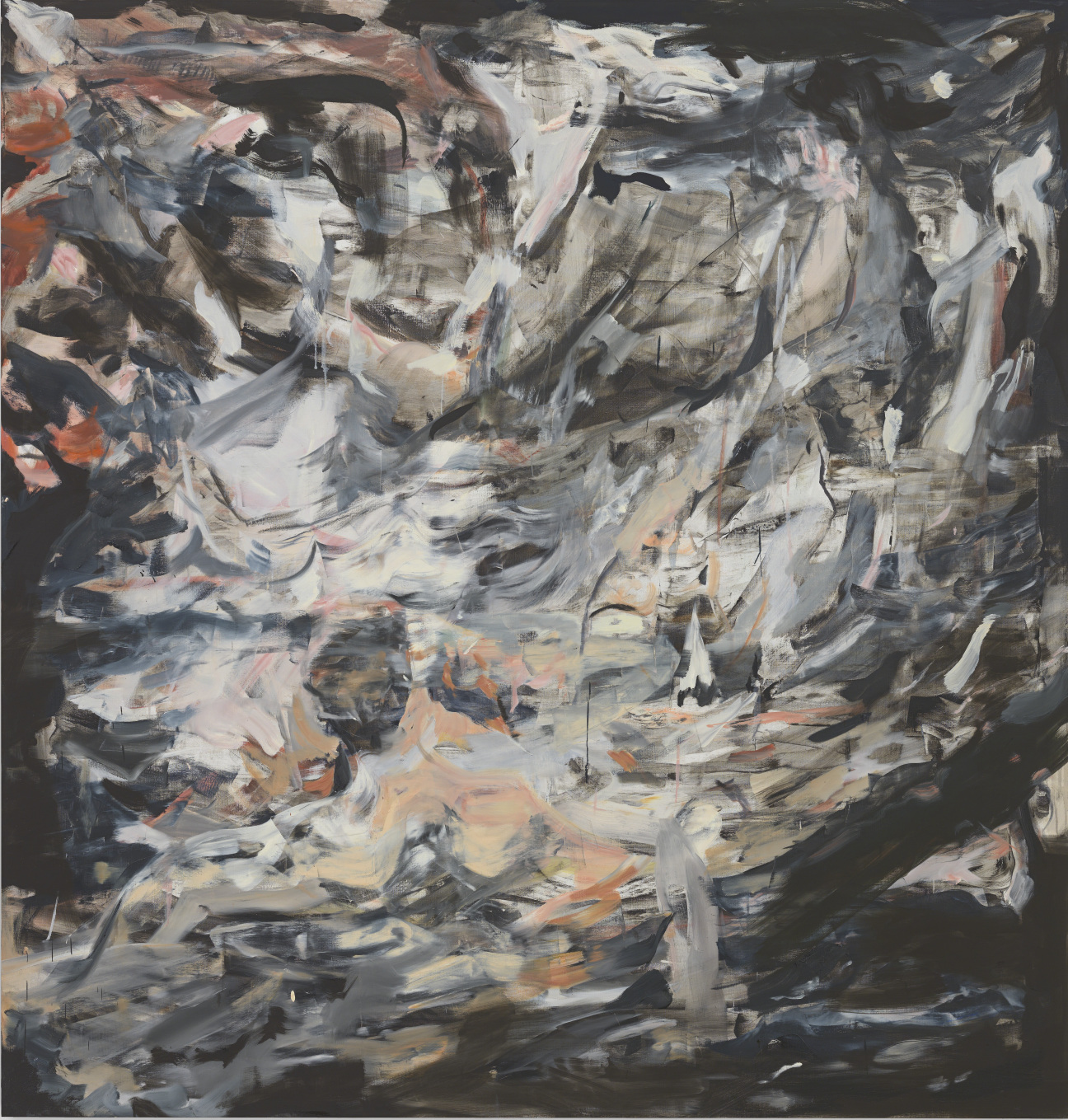
Brown emphasizes her desire for people to regard her work slowly, citing the phenomenon of finding images in clouds or rocks, and the perceptual toggling engaged by optical illusions. Her bunnies, redolent with sexual allusion and symbolic meanings, were also inspired by the famous 19th-century Rabbit and Duck drawing (in which you can see both animals, but not at the same time) used by Wittgenstein to explain his notion of aspect perception. A quick glance is not enough for the artist. The frequent characterization of her imagery as fragmented, flitting formally between abstraction and figuration, only scrapes the surface of her concerns—as does a narrow focus on the discursive content produced by her virtuosic ability to metabolize and transform her art-historical sources.
That said, the subject matter she pursues, the painterly motifs and genres she exhausts in her work, are defining. Though the survey is not ordered chronologically, Brown’s paintings can often—not always—be periodized by their theme. And each category here (such as “In the Night Garden” and “Sirens and Shipwrecks”) provides opportunities for embedded social critique as well as formal exploration. Discussing the works included among the landscapes, the artist recalls asking herself, “How little do you need to give for the brain to fill in the rest?” She played with using the “tiniest splash of light blue and green” to signal fields or foliage and sky. At the same time, the flurries and congested areas of paint (which Brown describes as “gnarly”) in the outdoor scene of an untitled painting from 2005, articulate a strange and suspenseful moment in the biblical story of Susanna—offering an opening for the artist’s commentary.
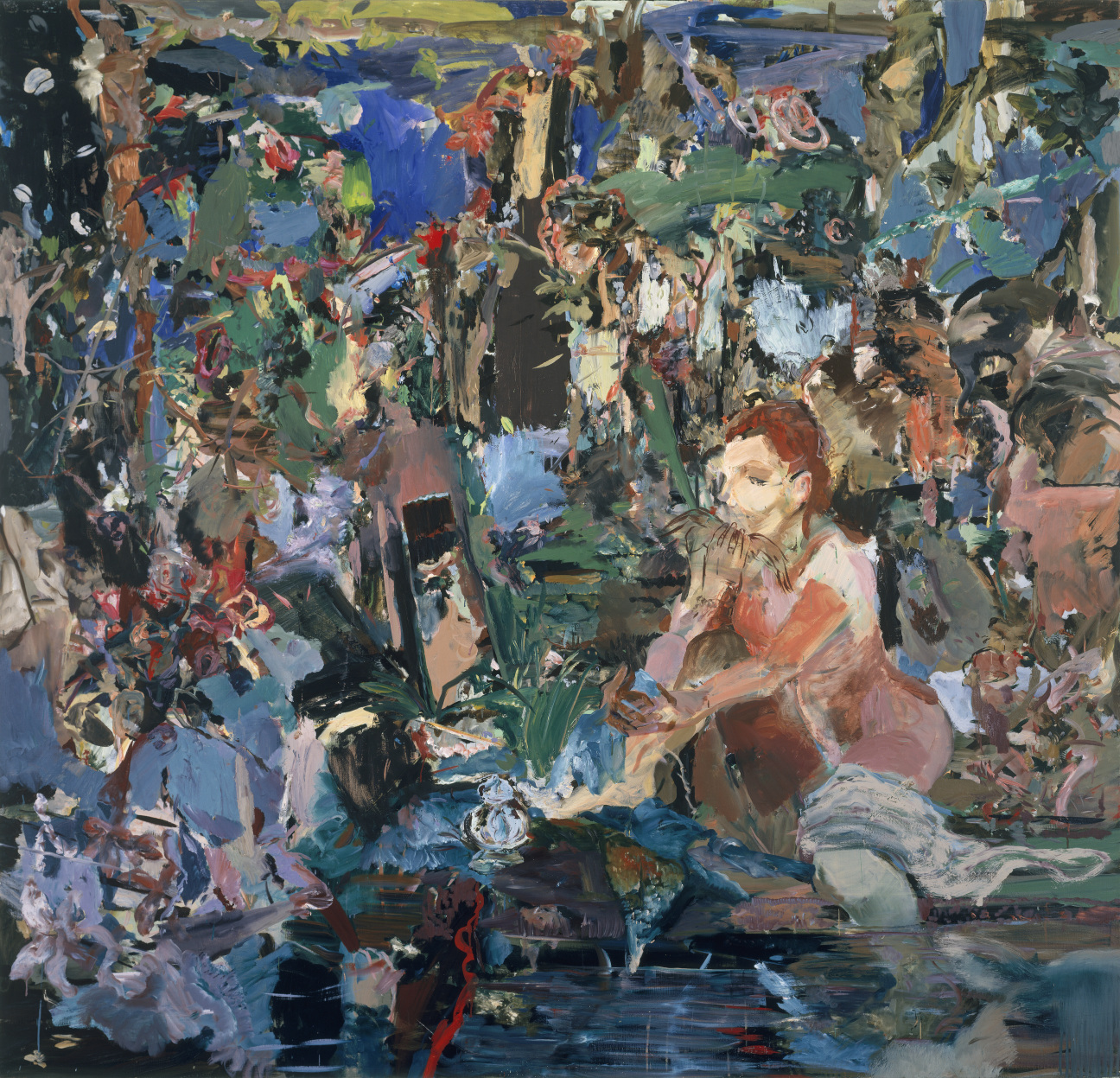
Susanna is shown bathing, undressed, her smudged reflection in a pool, just before she is accosted by two “elders” who attempt to extort sex from her (promising to publicly accuse her of adultery if she does not assent). Brown points out a ghoulish profile on the right—exemplary of the kind of camouflaged voyeur she likes to include, and notes that, in her version of the story, Susanna is devouring a bird. “I was very uncomfortable doing a picture of a woman just sitting there to be looked at,” the painter says, reiterating a rule she long ago made for herself.
A still-life by definition just sits there, and perhaps that’s why Brown came to the genre much later; and why she zeroed in on the 17th-century Flemish animalier Frans Snyders, whose gruesomely opulent compositions bring the thrill and terror of the hunt inside. The Splendid Table, 2019-20, a monumentally scaled, three-panel work inspired by his distressing banquet spreads, is the largest painting in the show and feels like both its crescendo and coda. A red tablecloth, spanning some 25 feet, is piled with carcasses: the floppy bodies of geese, deer—and bunnies. The whorling paint, in the artist’s familiar flesh-and-fire palette, recalls viscera and drapery, maybe incubi, as well as the shattered timber and chaos of her nearby shipwreck paintings.
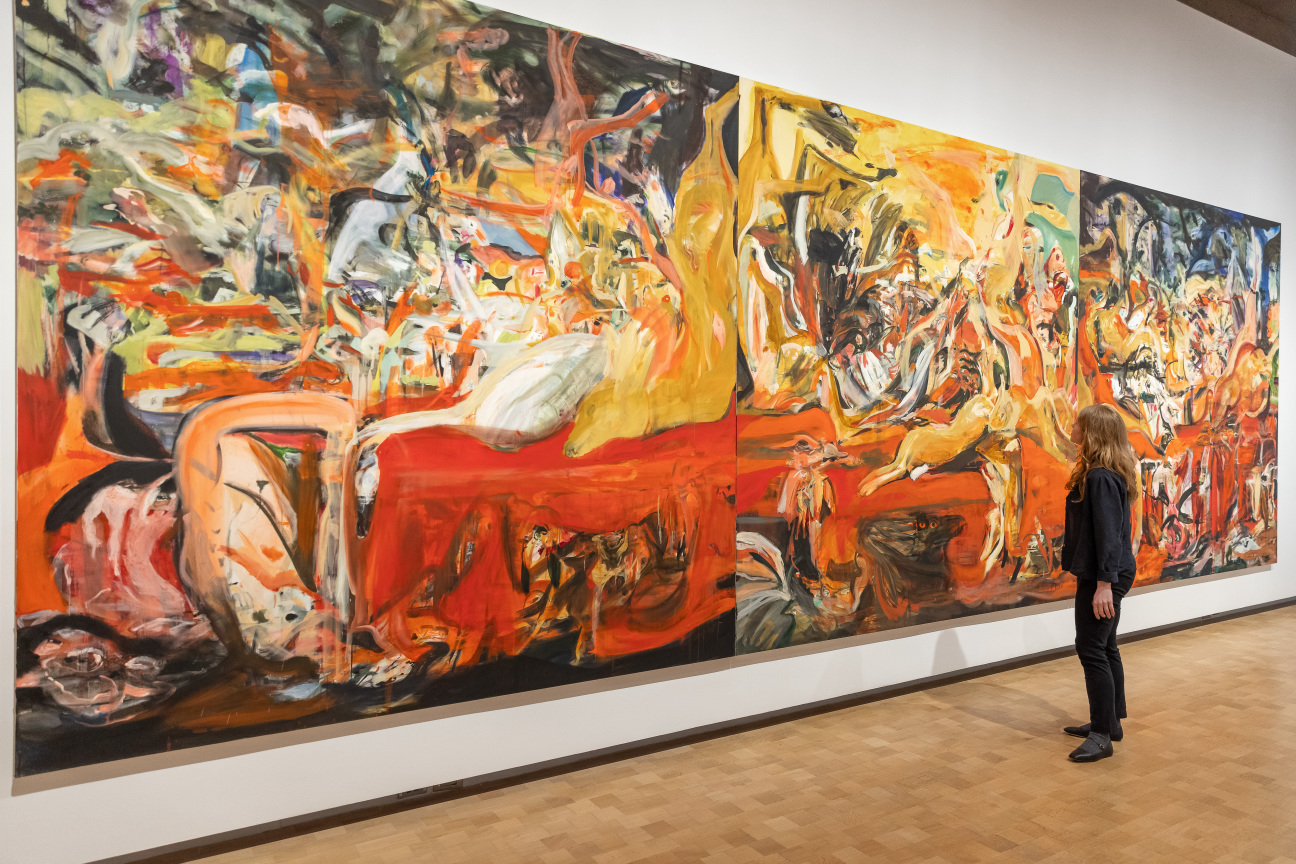
It's here that the feminist critique in Brown’s work sings loudest, though it's not a statement of boldness in terms of early Madonna-era controversy—not in its imagery anyway. Instead, its inferno of brushstrokes is a treatise on patriarchal violence in which the hunt and the hunter are indicted by the lush image of their kill; instead of a lurking voyeur, the red eyes of a cat look back at us from the darkness beneath the table. “Themes and Variations” is predictably strong, as most any cross-section of the painter’s work would be. Even better, it’s moving evidence of just how Brown made good on her youthful promise, the buzz around her steadily drowned out—over decades—by her roar.

